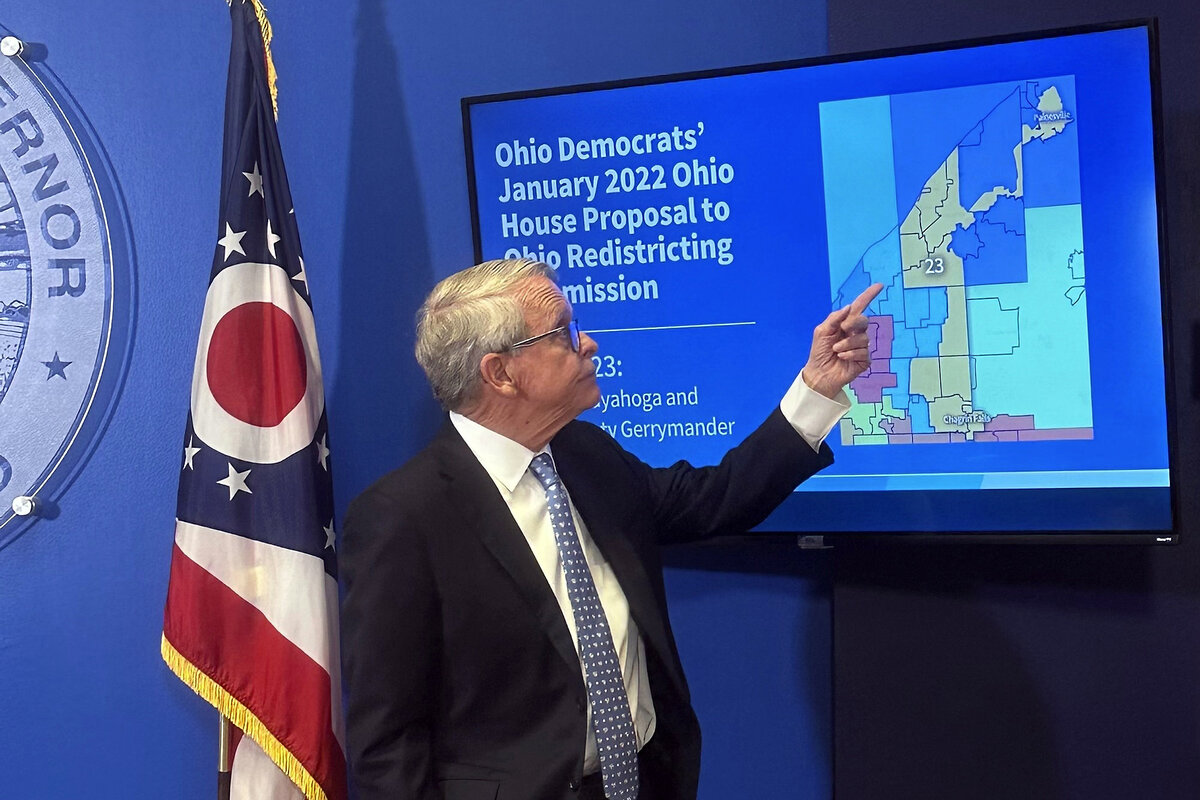Trump has opened up ‘a nuclear arms race’ on gerrymandering
Loading...
| Washington
President Donald Trump’s demand that Republicans draw more House districts to their advantage is threatening to set off a multistate brawl of naked political opportunism that could go a long way toward determining who controls the House next year, no matter how the voters themselves feel.
Texas Republicans are meeting in a special session where they plan to redraw the state’s congressional map, a move that could give them as many as five more House seats – more than the margin of their current House majority. Republicans are also redrawing Ohio’s congressional map, where they could squeeze out as many as three more seats, and are eyeing other states too as they try to maximize their structural advantage ahead of the 2026 midterm elections.
The bare-knuckled political fight was started by the White House. Last week, President Trump told Texas’ GOP congressional delegation that he wanted a new map in their state. Mr. Trump afterward that “I think we get five” seats in Texas with a new map, and “we’re going to get another three, or four or five in addition” from other states.
Why We Wrote This
Republicans in Texas are heeding President Trump’s request to change congressional districts as a way of protecting the GOP’s House majority in next year’s midterm elections. Democrats warn they’ll do the same in states they control as they sense a chance to flip the chamber.
Democrats are promising to fight back, warning that they may attempt new gerrymanders of their own in states they control – and predicting that Republicans could get greedy and overstretch their maps by moving too many Republican voters out of their current districts to create new ones and putting their own incumbents at risk.
“Every blue state should be looking at doing this mid-decade redistricting if Republicans are going to do it,” says Rep. Ted Lieu, a member of House Democratic leadership.
That includes in Representative Lieu’s home state of California, where Democrats are openly talking about overturning their state’s nonpartisan redistricting process.
The state-by-state fight could play a huge role in determining which party wins the House in 2026 – Democrats’ best chance of breaking Republicans’ unified control of the federal government and gaining a check on the president’s aggressive agenda in Washington.
“This is a nuclear arms race for House control,” says Dave Wasserman, an elections analyst at the nonpartisan Cook Political Report.
In fact, gerrymandering played a key role in giving Republicans their current House majority. They redrew a map in North Carolina before the last election that handed them three new House seats – and then won House control by that exact margin. Without that map, every major GOP agenda item Congress has passed for Mr. Trump this year would not have become law.
Redistricting occurs at the beginning of each decade, after new census data requires states to redraw their lines, and since the dawn of the republic has often been a sharp-elbowed affair. The term gerrymandering, or partisan redistricting, is named after founding father Elbridge Gerry.
Mid-decade redistricting was once vanishingly rare, considered by both parties a partisan bridge too far. But ever since Texas Republicans did an aggressive remapping in 2003 that gave the GOP six more House seats, they’ve become more and more common.
This has coincided with technological advances in map-drawing and voter behavior research that has made gerrymandering significantly more effective in the past two decades. Politicians now know exactly which voters they’re drawing into which districts, and can be much more precise and exacting than ever before.
But as Democrats gear up to fight the GOP with new maps, they face much longer odds at success because of state-level limits on gerrymandering. A bipartisan push to end the practice and limit political parties’ ability to dominate states with little input from voters has proved popular with voters from across the political spectrum. Many states have adopted limits on gerrymandering over the past two decades, precisely to avoid the kind of brazen rigging of state maps that both sides are threatening today.
“Democrats in several states are being faced with the challenge of going to a gunfight with a rubber knife,” says Jeff Wice, a former redistricting counsel for the Democratic National Committee who is now a professor at New York Law School.
In California, Democrats’ best opportunity to gerrymander a number of additional seats, the party would first need to convince voters to repeal their state’s independent redistricting commission in a statewide referendum.
Representative Lieu said he backed the creation of that commission when it passed in 2008 – and that he now regrets it, given Republicans’ recent actions.
“I was wrong,” he says. “We have to respond.”
Trump’s Texas push
A number of Texas GOP congressmen have been frustrated with the push from the White House. The map they currently have was designed to protect them for the decade as the state’s fast-changing demographic shifts threatened to make a number of their seats competitive. But they, and Texas Republican Gov. Greg Abbott, have been willing to go along at Mr. Trump’s insistence.
“We’re team players in the delegation. We did our own maps. We drew them. Everybody agreed, we got them passed,” says Rep. Michael McCaul. “But we’re willing to work with the White House.”
Republicans already hold 25 of the state’s 38 House seats, even though Democrats regularly win more than 40% of the vote in statewide races. Mr. Trump is pushing them to draw five more GOP districts.
Democrats Henry Cuellar and Vicente Gonzalez already represent districts Mr. Trump won in the state’s rightward-trending, heavily Hispanic Rio Grande Valley, and Republicans are likely to make those districts even more conservative in a redraw without disrupting their own incumbents much. They could also potentially target one or two Democratic seats in Houston as well as the one held by Rep. Marc Veasey in Dallas-Fort Worth.
But House Republicans don’t want to take on vast numbers of new voters or face tough races just so the GOP can pick up a few more seats, and are lobbying their state legislative allies back in Texas not to mess with their district lines, which could limit how aggressive a gerrymander the new map is.
The Texas legislature would need to pass new maps by the end of a 30-day special session that began on Monday for them to be used next year.
Last week, Mr. Trump told the Monitor during a gaggle with reporters that there were “about four” other states where Republicans should redraw the maps besides Texas. Though he declined to say which were on the list. He said three states could yield one more House seat for the GOP and a fourth could yield two to three more. Add that to Texas, and that could add up to as many as 10 more safe Republican seats heading into the midterms.
That bigger prize he referred to is likely Ohio, where Republicans were already set to redraw their congressional map before Mr. Trump’s push. A quirk in state law related to the state’s fairly toothless anti-gerrymandering law has forced them to draw a new map, and they have unchecked control of the levers of power to do so. Republicans are privately eyeing changes to tilt the swing districts of Democratic Reps. Marcy Kaptur and Emilia Sykes in northern Ohio to make them more Republican. They may also target Rep. Greg Landsman’s Cincinnati-based district as well, though one obstacle is state anti-gerrymandering laws limiting how much counties can be split in redistricting.
Missouri Republicans are reportedly looking at drawing a new map that would erase Democratic Rep. Emanuel Cleaver’s district, splitting it into two Republican districts. Florida Republicans have already drawn an aggressive gerrymander that was upheld by the conservative-dominated state supreme court in spite of a “fair districts” constitutional amendment voters approved a few years ago. Given the state’s recent rightward drift, Republicans there could target even more Democrats. They could also seek to shore up an Omaha-based seat in Nebraska that Democrats think they are likely to flip next election – and may try to go after Democratic Rep. Sharice Davids in Kansas as well.
Eyes on California
Democrats are promising to respond in kind if Texas Republicans move ahead.
“We’re not going to fight with one arm tied behind our back,” Democratic Congressional Campaign Committee Chair Suzan DelBene, a Washington state Democrat, said at a Monitor Breakfast Wednesday. “Republicans should be careful what they ask for because Republicans are going to lose seats if this is the path that they go down.”
But Democrats’ options are much more limited.
Over the past few decades, a number of red and blue states including New Jersey, New York, Arizona, Ohio and Florida have passed laws and constitutional amendments limiting or barring gerrymandering. But while judges in more liberal-leaning states have largely enforced those restrictions assiduously, in red-leaning states that have adopted similar measures, conservative state judges have often allowed Republican lawmakers to skirt the new rules.
In 2008, California voters ended partisan gerrymandering by the legislature and approved an independent redistricting commission. Democrats have 43 of the state’s 52 House seats, but an aggressive gerrymander could potentially give them two or three more.
California Democratic Gov. Gavin Newsom declared that if Texas moves ahead with a new gerrymander, he’d push California to overturn its independent citizens redistricting commission and let Democrats draw a partisan map of their own.
“If these guys are literally going to rig, de facto, the outcome of November next year, I can’t just sit back passively,” the California governor said in a recent episode of his podcast.
For California Democrats to be successful, they’d need to get voters to pass a statewide ballot proposition repealing their independent commission. That could be a tough sell: Voters approved the commission by 61%-38% in 2008.
California Democratic Rep. Mark Takano said that it’ll be an “expensive” and uncertain process to pass a statewide proposition – but that he thought a majority of Californians would come around to understanding that Mr. Trump was the bigger threat.
“The voters of California… they don’t like the idea of politicians drawing their own districts. And I agree with that,” he said. “But this isn’t about political deals. This is about the future of our democracy and the future of our country. … I think Californians are very interested in seeing a check being put on Donald Trump’s power.”
California Republican Rep. Darrell Issa said that the independent redistricting commission was a farce dominated by Democrats. “Gerrymandering is already there,” he says, arguing that if Governor Newsom “is doing it in an open and ruthless fashion” it wouldn’t make a huge difference.
New York and New Jersey, where Democrats could theoretically draw more Democratic-leaning districts, both have constitutional bans on mid-decade redistricting, as well as limits on partisan gerrymandering.
Even where Democrats have unified control and a relatively free hand to re-gerrymander, they’re pretty maxed out. Illinois Democrats already hold 14 of the state’s 17 House seats, even though Mr. Trump won 43% of the statewide vote.
Maryland Democrats about drawing a new congressional map that would carve up the state’s only Republican district, held by Rep. Andy Harris. But Rep. Steny Hoyer, the dean of Maryland’s House delegation, says there was no way to draw a “rational map” that would give Democrats all eight congressional seats in the state. If it were possible, “it would have been done,” he said with a laugh. “Eight-oh would be a map that would be tough to sell to the courts,” he said.
In Washington state, Democrats already hold eight of 10 House districts, and a bipartisan redistricting commission draws the state’s maps. Local Democratic leaders said this week that it would be all but impossible to draw a more partisan map.
“Some places it’s going to be more challenging than others,” Ms. DelBene said after Wednesday’s Monitor Breakfast.









